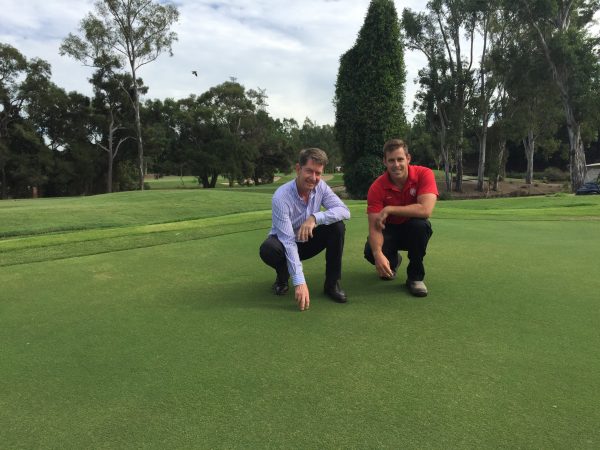
NO golfer, irrespective of his or her handicap, walks off a green after a three putt feeling good about themselves.
And while The Brisbane Golf Club cannot guarantee a golfer’s most detested deficiency never occurring on their greens, club captain Terry Campbell is adamant the probability has greatly decreased now the course has Ultra Dwarf Bermuda Champion greens.
The new strain of grass comes under the well-known US Champion Turf Farms umbrella, with more than 700 courses in America growing their product, including Pinehurst, the venue for the 2014 US Open.
“What we can guarantee at The Brisbane Golf Club, on our new greens, is a smoother, faster and more consistent ball roll,” Campbell said.
“Golfers able to read the slope of the green and judge the pace of the surface can putt with the confidence that the ball will go exactly where it is aimed.”
Campbell, who has been a member at The Brisbane Golf Club for 28 years and course chairman for five, says that because of the heat and the humidity, growing grass without grain on Queensland golf greens has been almost impossible in the past.
“But Champion is a smaller leaf grass, able to be mown closer, has great colour with terrific speed and consistency,” he said.
“Good maintenance practices are required and with this the grain is reduced and exceptional putting surfaces produced.”
Discussions on growing new greens at the club started in 2011.
Because of their age and severe encroachment from other grass species into the existing Bermuda 328 greens, the need for major work became obvious.
“Our course superintendent at the time, Brett Morris, had been exposed to Champion grass and he recommended we investigate installing it here,” Campbell explained.
“We made contact with the Department of Primary Industries, obtained stolons from them, established our own test nursery and propagated all the stolons needed for our 21 greens.
“That was in February of 2012 and the first two greens to be done – the sixth and the 13th – were stolonised with Ultra Dwarf Bermuda Champion in November 2012 and in play by late March 2013.”
With 21 holes, the club was mostly able to curtail any major disruptions although three temporary greens have been in play during the past 18 months.
In January this year five new greens came in to play and just two remain to complete the transformation.
These holes – two and eight – need major reconstructive work on greens and fairways and they are expected to be back in play by the end of June.
“It has been a long, tedious and expensive exercise, but it had to be done,” Campbell said.
“Some greens have cost us as little as $10,000 – others $30,000.
“And the reconstruction of the eighth hole will be in the vicinity of $120,000. We believe ours will be the best warm-weather greens in Australia.”
While the end result will be worth the angst, Campbell said the club had “worn some flak” from members during the redevelopment.
“For three years now our members have not been able to play our best 18-hole layout,” he said.
“It has been frustrating for them and we can understand their anguish. But the greater majority are now saying ‘the club did the right thing’, and that positive feedback is extremely satisfying.”
If the greens are so great, and make putting more pleasurable and less of a science, why aren’t other golf clubs in Queensland installing the Ultra Dwarf Bermuda?
Because, says Campbell, the grass is no longer available in Australia.
“We would love to talk to interested clubs about this grass, but how we get it to them is another question,” he said.
Campbell praised the work and enthusiasm of current course superintendent Mitch Hayes and his staff, who have refined the growing and maintenance process over the past two years so the club has fast and consistent putting surfaces.
“Mitch had 18 months in the US and is well versed in this grass,” he said.
“He and his staff have done an absolutely phenomenal job on the course. Their attention to detail is what has made the biggest difference in this project.”




![Win the golfing experience of a lifetime, at the Hawai‘i International Week of Golf, valued at $6,900 [Winner Announced] Win the golfing experience of a lifetime, at the Hawai‘i International Week of Golf, valued at $6,900 [Winner Announced]](https://www.insidegolf.com.au/wp-content/uploads/Hawaii-Comp-500x294.jpg)